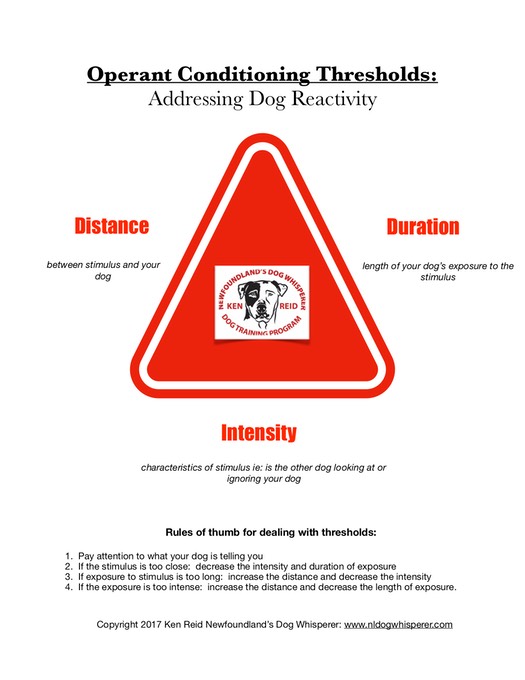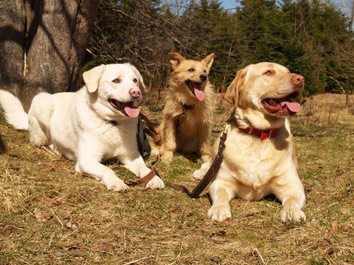
The human race is rife with opinions.
Should one use milk in the making of an omelette? What is better, Coke or Pepsi? What makes for better advances, the closed wall approach of Apple or the open ecosystem of Google?
Opinions mean diversity and result in discussion. Opinions can be a good thing of which people are entitled. Remember however, just because you have an opinion on something, it does not mean you are right.
There tend to be two schools of thought when one examines dog training.
One side is dominated by the old alpha dog approach. It is a very reactive means to address problems. The idea that “might makes right, that our dogs are opportunistic status seekers constantly trying to climb some imagined hierarchy. Proponents of this approach are strong believers in discipline. The belief is that if you assert your dominance over your dog, show him who is boss, problem behaviors will disappear. The idea is your dog needs a strong firm leader without which, he will try to take the lead in his human pack and chaos ensues. Methods include using many intangible difficult to measure tools such as “having a calm assertive energy”, and ensuring you project your confidence onto your dog. A practitioner would use energy into doing things like corrections, and alpha rolls. When addressing issues like dog reactivity, proponents of this type of thinking would suggest exposing your dog to other dogs, continuously correcting the "bad behavior” until your dog no longer displays outward reactions. Sometimes this works, or at least it appears to do so. Supporters will often say “this is what I did and it worked for me” to give credence to the approach. It is a problematic approach with many potential drawbacks.
The other side is rooted in science. It is a proactive method to behavior modification. At it’s core is a long accepted principle in psychology called OPERANT CONDITIONING. Proponents of this approach believe that dogs are creatures who exist and are influenced by their environment. They learn based upon feedback given. Sometimes they develop fears or insecurities of certain things. People using this theoretical framework believe one can address issues such as dog reactivity through exploration of where a dogs’ comfort zone is. Once thresholds are discovered, an owner can use positive reinforcement strategies to encourage a dog to develop positive associations with the negative stimuli, voluntarily pushing their own envelops and building the dog’s confidence in themselves and in you, the owner. Tools include the use of training trials, using classical conditioning strategies and systematic feedback. Supporters of this framework will tell you it does not have the drawbacks inherent in the alpha dog approach. The results tend to be longer lasting but do require skill, timing and patience. For more on operant conditioning see Sarita’s guest post “The use of classical and operant conditioning in dog training"

The idea that dogs have THRESHOLDS is something I discuss extensively with clients in one on one behavior modification sessions and group class. It is not a complicated concept but it does tend to be one many clients are hesitant to accept in practical situations. There seems to be a disconnect. They understand the concept, can grasp the exercises allowing them to put the concept into practice but run into problems with adapting the practice to everyday situations. To be fair, it can seem counterintuitive. You walk your dog, you come across another dog, your dog reacts negatively….you do nothing? No corrections? No reprimand? “But…but….how is my dog supposed to learn anything?” Humans seemed to be programed to think...
punishment needs to happen for a undersireable behaviour to be extinguished.
Of course, people who study the behavior sciences will tell you that it is not always as cut and dry as that. Experts realise that punishment should be a last ditch attempt to correct a behavior, that there are degrees of punishment and that just because one is thinking of using punishment, it does not have to be mean or to hurt. If it does not have to, than it shouldn’t. For more on this topic, refer to the humane hierarchy.
One of the many problems using punishment to address dog reactivity is you are trying to make a square peg fit into a round hole. It is the wrong tool for the job. You are defeating your dog before you start. In the case above, you are accepting the idea of thresholds but not altering your daily activity so you can put the exercises into practice. It is like advising a person who is learning how to swim to stay in the shallow end, get comfortable with the water, have some fun, and learn some of the strokes before going into the deep end…then the person asking “but what happens if I find myself in the deep end”. The answer…”DON’T”. Avoid it at all costs. If you cannot avoid it, take precautions. Wear a life jacket, ensure others are around, stay close to the side. Get comfortable in the water, and develop your skills before proceding to the deep end.
The same is true dealing with dog reactivity. Avoid situations where you encounter other dogs and cannot manipulate training parameters. If you cannot avoid, take precautions. Cross the road, place yourself between your dog and the other dog, change walking patterns and areas. In short, set your dog up for success. whatever you do, resist punishing your dog. Why? Well, for more on that, read “Why punishment does not work”. Remember, you have to get your dog comfortable and enjoying other dogs if you want a different reaction.
Here is a diagram I recently developed to help explain threshold practice.

When using the idea of thresholds, one needs to be aware of and have the ability to manipulate the the training parameters involved. If you do not, you are basically using the concept of FLOODING, to achieve behavior modification. For more on flooding and why it often leads to poor results, see “Flooding and desensitization"
A couple of things to note when engaging in this type of behavior modification:
1. It takes time. Results will not happen overnight. Practice, practice practice
2. Setbacks are common. Some days dogs will do better than others. That is normal. Work with the setbacks, learn from them and grow.
3. Patience is a virtue. Remember you are attempting to change your dog’s perception of a negative stimuli so that he no longer feels the need to react negatively to it, or even better, he starts to like it. Doing so will ensure the results are longer lasting.
4. This is not a passive feedback process. It requires active engagement from the owner. The process requires an owner be proactive as opposed to reactive. Frankly, when done right, it can be exhausting. However, the results are rewarding.
The group dog walks are full of people on this journey with their dogs. Some are on the later stages of the journey enjoying the fruits of their work. Others are still at the beginning. The success stories section of this site is full of personal stories or challenges, growth and triumphs. It is worth the read.
Operant conditioning is a invaluable tool in any dog owner’s arsenal. It is not a difficult tool to use but it takes understanding and patience to use effectively. When used correctly, behavior modification occurs and that is a beautiful thing.
